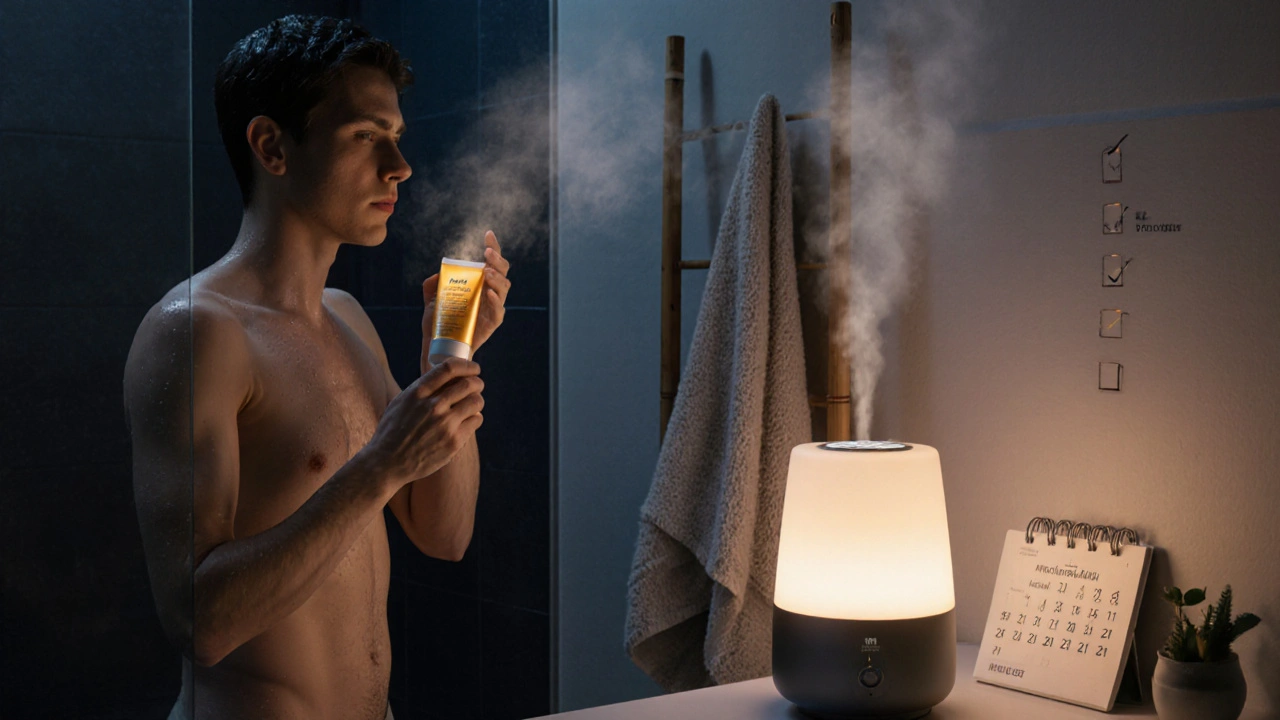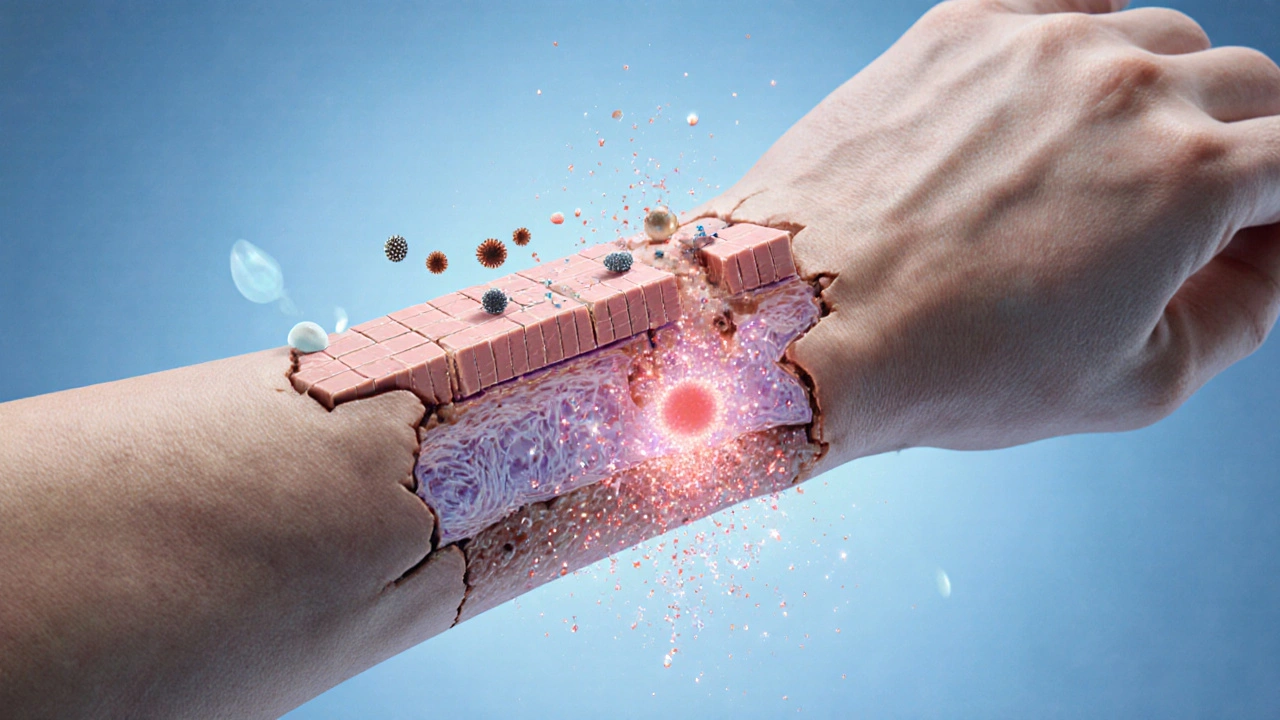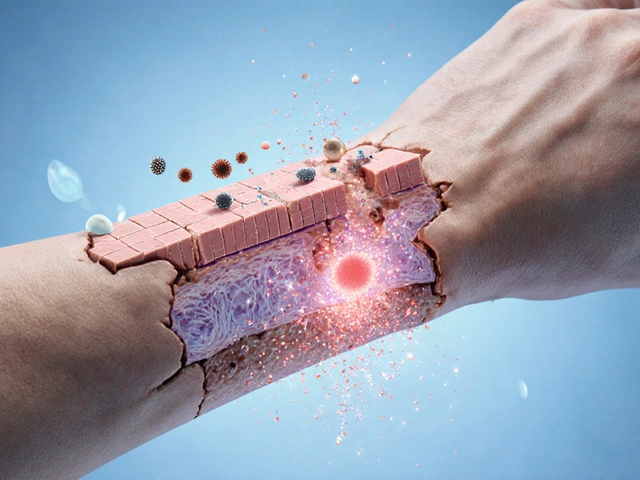Allergy Trigger Checker
Identify potential allergens contributing to your skin inflammation and get personalized management recommendations based on your symptoms and exposure history.
Key Takeaways
- Allergic dermatitis is the skin’s direct response to an allergen, driven by histamine and cytokine release.
- A compromised skin barrier lets allergens penetrate more easily, worsening inflammation.
- Identifying and avoiding triggers, plus supporting the barrier, can dramatically reduce flare‑ups.
- Over‑the‑counter antihistamines and moisturizers are useful first‑line tools, while prescription options target deeper immune pathways.
- Regular check‑ins with a healthcare professional help keep the cycle of allergy‑induced inflammation in check.
When skin starts itching, reddening, or blistering, most people think of a rash. But behind that surface change is often a complex dance between an allergy and the body’s immune system. Understanding how a simple allergic reaction can snowball into full‑blown skin inflammation is the first step toward lasting relief.
Allergic dermatitis is an inflammation of the skin that occurs after an allergen triggers an immune response. It’s the umbrella term for conditions like atopic dermatitis (commonly called eczema), contact dermatitis, and even hives when they appear on larger skin areas. The common thread? A wave of histamine release that makes blood vessels leak, nerves fire, and skin swell.
How an Allergy Sets Off Skin Inflammation
The cascade starts the moment an allergen-think pollen, pet dander, a nickel ring, or a fragrance-breaks through the outermost skin layer, the skin barrier a protective matrix of lipids and proteins that keeps irritants out and moisture in. When that barrier is weak (dry skin, genetic factors, or over‑cleansing), allergens slip in and meet resident immune cells.
Key players are mast cells white blood cells packed with granules of histamine and other mediators. Upon recognizing an allergen, mast cells de‑granulate, dumping histamine, tryptase, and a suite of cytokines signaling proteins that recruit more immune cells to the site. The result is the classic triad of redness, swelling, and itching.
Why does the skin swell instead of staying calm? Histamine binds to H1 receptors on tiny blood vessels, causing them to dilate and become leaky. Fluid leaks into surrounding tissue, creating that puffed‑up feel. At the same time, nerve endings become hypersensitive, turning a mild tickle into an unbearable itch.
Common Forms of Allergic Skin Inflammation
Not all rashes are created equal. Below are the three most frequent allergic skin conditions, each with its own trigger profile and typical appearance.
| Condition | Typical Triggers | Presentation | Key Management Steps |
|---|---|---|---|
| Atopic dermatitis chronic, genetically linked eczema | Dust mites, pollen, food allergens, dry climate | Dry, scaly patches; intense itch; often on elbows, knees | Barrier repair moisturizers, topical steroids, antihistamines |
| Contact dermatitis reaction to direct skin contact with an irritant or allergen | Nickel, fragrances, detergents, latex | Red, itchy rash confined to area of contact; may blister | Avoid trigger, cool compresses, topical calcineurin inhibitors |
| Urticaria (hives) transient, raised welts caused by histamine release | Foods, drugs, insect stings, physical stimuli | Raised, pink or red welts that move around; last <24hrs per spot | Second‑generation antihistamines, trigger avoidance |
Why the Skin Barrier Matters
Think of the skin barrier as a brick wall. Healthy bricks (lipids) keep the bad guys out. When the wall has gaps, allergens slip through and set off the immune cascade described earlier.
Two main factors weaken the barrier:
- Genetics: Mutations in the filaggrin gene reduce natural moisturizing factors, a common root in atopic dermatitis.
- Environmental habits: Frequent hot showers, harsh soaps, and over‑exfoliation strip away lipids.
Repairing the barrier is as important as calming the immune response. Look for moisturizers that contain ceramides, cholesterol, and fatty acids in a 3:1:1 ratio-these mimic the skin’s natural composition.
Practical Steps to Calm the Inflammation
When you recognize that an allergen is making your skin angry, you have three fronts to attack: remove the trigger, soothe the immune reaction, and rebuild the barrier.
- Trigger elimination: Keep a simple diary for two weeks. Note foods, new skincare products, and activities alongside any flare‑ups. Once a pattern emerges, cut the suspected culprit.
- Antihistamines: Second‑generation options like cetirizine or loratadine reduce itch without causing drowsiness. Take them daily during an active flare.
- Topical anti‑inflammatories: Low‑potency steroids (hydrocortisone 1%) are safe for short bursts on small areas. For sensitive zones, non‑steroidal calcineurin inhibitors (tacrolimus) work without skin thinning.
- Moisturizing routine: Apply a barrier‑repair cream within three minutes of showering while the skin is still damp. Re‑apply at least twice a day.
- Cool compresses: A cold, wet cloth for 10‑15 minutes can shrink blood vessels, giving instant relief from redness.
When to Seek Professional Help
If you notice any of these red flags, it’s time to call a dermatologist or your GP:
- Rash spreads rapidly or covers large body areas.
- Blisters burst, ooze, or form a crust.
- Symptoms persist despite two weeks of proper self‑care.
- You develop fever, joint pain, or swelling elsewhere.
Doctors may order skin‑prick tests or patch testing to pinpoint the exact allergen. In severe cases, prescription‑strength steroids, phototherapy, or biologic drugs that block specific cytokines (like dupilumab) become necessary.

Long‑Term Lifestyle Tweaks
Even after you’ve tamed a flare, the underlying allergy‑inflammation loop can reignite. Here are habits that keep the skin calm for months to years:
- Humidify indoor air: Aim for 40‑50% humidity, especially in winter, to prevent skin drying.
- Choose fragrance‑free products: Look for “unscented” or “hypoallergenic” labels. Avoid “parfum” on ingredient lists.
- Wear breathable fabrics: Cotton and bamboo let sweat evaporate, reducing irritation.
- Mind your diet: Omega‑3 rich foods (salmon, flaxseeds) have anti‑inflammatory benefits. Some people find relief by limiting high‑histamine foods like aged cheese and fermented drinks.
- Regular exercise: Improves circulation and reduces stress, both of which can lower histamine release.
Remember, the goal isn’t just to stop the itch today-it’s to create a skin environment that refuses to react tomorrow.
Bottom Line
The link between allergies and skin inflammation is a straightforward chain: a weak skin barrier lets an allergen in, mast cells unleash histamine, and cytokines rally more immune fighters, resulting in redness, swelling, and intense itching. By strengthening that barrier, cutting out triggers, and using targeted anti‑inflammatory tools, most people can keep allergic dermatitis under control without constant doctor visits.
Frequently Asked Questions
Can a food allergy cause a skin rash?
Yes. When you eat a food you’re allergic to, the immune system can release histamine systemically. This often shows up as hives or an eczema flare‑up, especially if the skin barrier is already compromised.
Is it safe to use over‑the‑counter steroid creams forever?
No. Long‑term use can thin the skin, cause stretch marks, and increase infection risk. They’re great for short bursts (a week or two) on active spots, but daily barrier repair moisturizers are the real maintenance tool.
What’s the difference between atopic dermatitis and contact dermatitis?
Atopic dermatitis is a chronic, often family‑linked condition triggered by airborne or food allergens and a weak barrier. Contact dermatitis is a localized reaction to something that physically touches the skin, like nickel or a cleaning product.
Do antihistamines help with eczema?
They can reduce itch caused by histamine, but they don’t treat the underlying barrier defect. Combining antihistamines with moisturizers and, if needed, topical steroids gives the best results.
How long does it take for a moisturiser to repair the skin barrier?
Visible improvement can appear within a few days, but full barrier restoration often takes 2‑4 weeks of consistent use. Stick with a ceramide‑rich formula and avoid harsh cleansers during that period.


One must recognize that the skin, as the body's outermost shield, bears the moral responsibility of maintaining its integrity against allergens; neglecting this duty invites suffering.
The data shows that over‑reliance on topical steroids without proper barrier restoration can exacerbate permeability, leading to a feedback loop of inflammation.
Imagine your skin as a vibrant tapestry, each thread woven with moisture and lipids; when an allergen sneaks in, it’s like a sudden splash of neon paint that disrupts the whole masterpiece.
What most people fail to see is that the very chemicals in our so‑called ‘hypoallergenic’ moisturizers are often engineered by hidden industry consortia to keep us dependent on perpetual product cycles. These formulations contain nanoscopic surfactants that subtly compromise the stratum corneum, making it more receptive to environmental allergens. The research papers quietly published in obscure journals reveal that the additives are linked to increased histamine release upon skin contact. Moreover, the supply chain for these additives is controlled by a handful of multinational corporations who lobby against stricter regulation. They fund laboratories that churn out data supporting their safety claims, while suppressing independent studies that point to the opposite. This creates a feedback loop where consumers purchase more products, inadvertently amplifying their own allergic load. It is not a coincidence that flare‑ups often coincide with the release of new product lines marketed as ‘advanced barrier creams’. The timing suggests a coordinated effort to synchronize marketing with the onset of skin sensitivity. Furthermore, the fragrance industry embeds phthalates that act as adjuvants, priming the immune system for overreaction. Even the packaging-often made of polymeric materials-can leach micro‑plastics that act as irritants. All of these factors combine to turn a simple allergic dermatitis into a chronic, self‑sustaining condition. Doctors are frequently unaware of these hidden variables because the medical education system has not caught up with industrial espionage tactics. Patients therefore receive prescriptions that treat symptoms but not the underlying engineered triggers. The solution lies in returning to truly simple, barrier‑supporting routines: plain petrolatum, fragrance‑free soaps, and avoidance of processed topical agents. Only then can we break the cycle of manipulation and restore our skin's natural resilience.
Stay hopeful; consistent skin care can truly transform your comfort.
Oh my dear friend, you speak such uplifting words, and I must say, the power of optimism truly shines like a beacon in the darkest of dermatitis storms, and let us not forget that a well‑timed moisturizer, applied with gentle hands, can be the very armor that shields us from the relentless assault of allergens, yes indeed, we must celebrate each small victory, each soothing cream, each moment of relief, for they are the threads that stitch together the tapestry of our healing journey!
One cannot simply dismiss the nuanced interplay of immunologic cascades as a mere footnote; the epidermal barrier functions as a sophisticated bio‑engineered fortress, and any perturbation warrants a scholarly investigation that transcends superficial remedies.
its true that the barrier is complex but most people just need simple steps like plain ointment and avoiding nickel
It is imperative to recognize that the data presented by mainstream dermatological sources may be filtered through a veil of corporate sponsorship, thereby obscuring the true etiological agents that perpetuate allergic dermatitis.
yeah sure the big pharma pushes stuff but you can just use basic stuff like petroleum jelly and be fine.